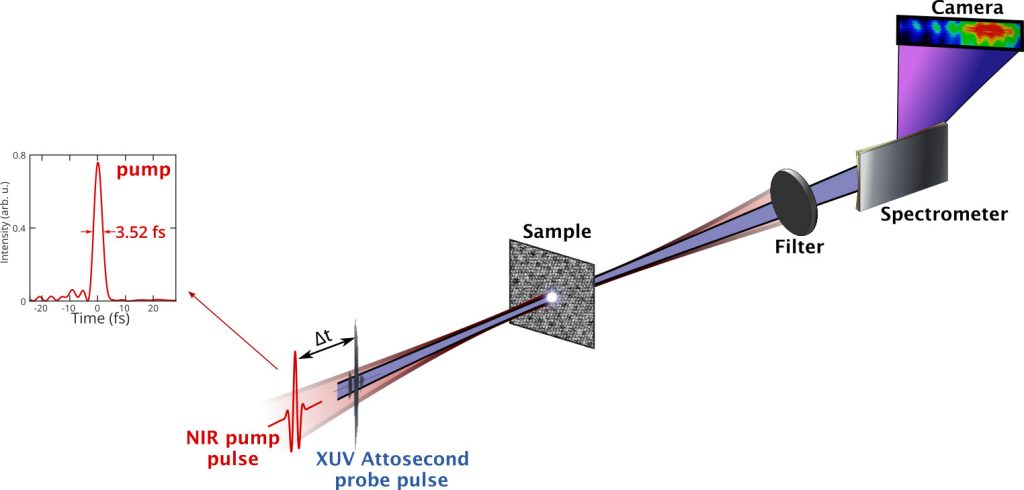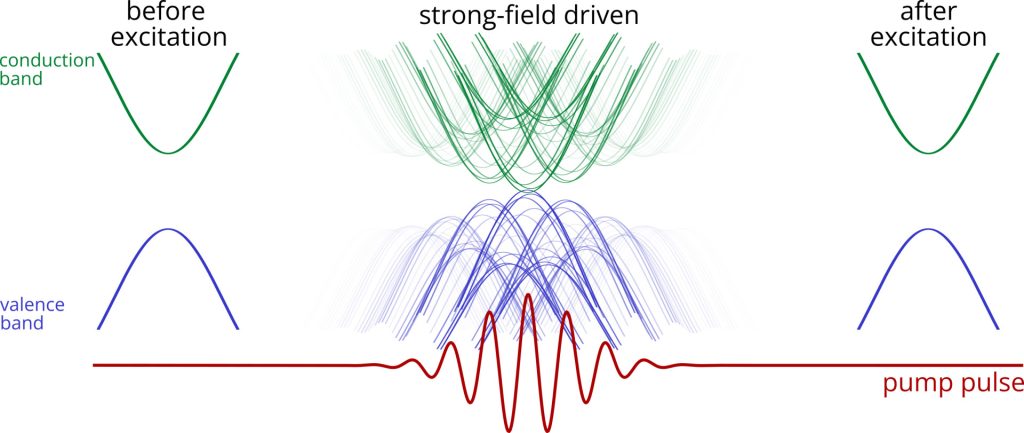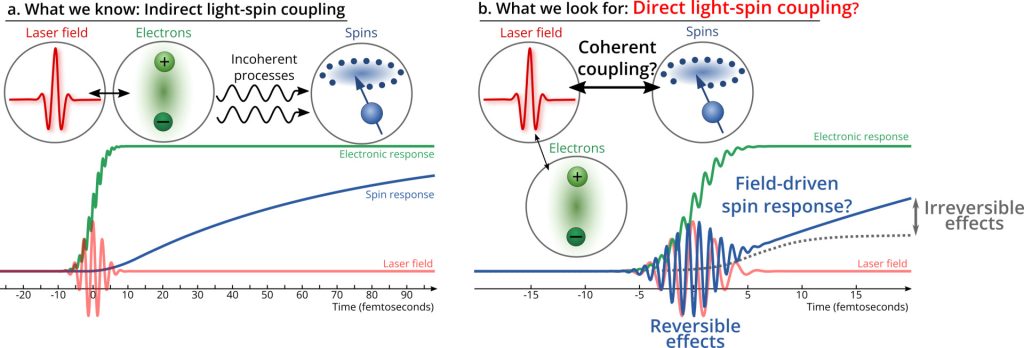Our group delves into the realm of ultrafast material science, focusing specifically on probing solids using the shortest light sources available today: pulses with attosecond (1 as = 10-18 s) time durations. Such pulses are obtained by high-harmonic generation in gases. Here is an example shown in the time and frequency domains. In this case the pulse is generated in an argon-filled gas cell :

Attosecond pulses offer two key properties:
- Exceptionally short time durations. This makes it possible to capture electronic dynamics, which typically take place in a few femtoseconds. Notably, the experimental resolution can now fall well below an optical-cycle of laser light.
- Broadband light with wavelengths in the extreme ultraviolet (XUV), or even x-rays. These photon energies are resonant with transitions from core-levels of the atoms of the sample to its valence and conduction bands. Therefore, the dynamics can be probed from the “point of view” of each atom. In a sense, this makes attosecond spectroscopy able to see what happens “inside” a material.
Attosecond transient absorption and reflectivity
We perform experiments on the Attolab platform of LIDYL. We operate a beamline dedicated to the spectroscopy of solids. In these experiments, the sample is first excited with a short optical pulse (<5 fs, see below), triggering dynamics of interest. Then, the broadband XUV radiation is used to probe its absorption or reflectivity, obtaining an analogue of more usual optical pump-probe spectroscopies. Here this scheme is shown in absorption geometry :

Remarkably, this technique is all-optical, meaning that both its time (set by the duration of the pulses) and spectral resolutions (set by the spectrometer resolution) can be optimally short and narrow, respectively.
Topics of interest
Strong-field physics in dielectrics
Dielectrics are transparent materials: under weak excitation, they do not absorb any energy from the pump beam. However, when the laser electric field becomes strong enough, it is possible to trigger numerous effects involving band structure modifications (see drawing shown below) as well as electron dynamics (e.g. tunneling, avalanche ionization). These strong-field phenomena can be spectacularly drastic; for instance, short light pulses can increase the AC conductivity of a solid by 18 orders of magnitude in less than a femtosecond, and electrons and holes have been observed to oscillate up to petahertz frequencies.

Attosecond spectroscopy allows us to watch these processes unfold, unveiling how strong laser pulse can manipulate materials on sub-femtosecond timescales, possibly in reversible ways. These high intensity phenomena are also important to understand because the interaction between light and dielectrics are ubiquitous in various optics and electronics application. For instance, field-driven currents in dielectrics is the fundamental phenomenon at the root of solid-state high-harmonic generation, which is also studied in the DICO group.
Coherent light-spin interactions
The control of electrons – that is, the charge of electrons – with light is becoming increasingly well-known on attosecond timescales. However, the control of the spin of electrons is much less developed. Most light-spin control schemes rely on indirect processes: light first excites electrons, which then relax in spin-dependent ways (see panel (a) below). This is the basis of femtosecond laser-induced demagnetization, but it only lead to relatively slow spin responses.

Interestingly, several reports provided evidence that more direct and coherent light-spin interactions could exist (see panel (b) below). Verifying these theories is very challenging: we need to adapt attosecond spectroscopy to be able to probe spin dynamics in materials at sub-femtosecond timescales, which has never been achieved yet. One of our project aims at achieving precisely that. We aim to perform XUV Magnetic Circular Dichroism with attosecond pulses, while keeping sub-100 as time resolution.
Ultrafast dynamics in strongly-correlated materials
We recently began investigating a new class of solids: the so-called strongly-correlated materials. This wide class of samples usually show unusual (and often useful) electronic and magnetic properties. Their common feature is that these properties cannot be described effectively in term of non-interacting electrons or non-interacting spins. Instead, the importance of electronic correlation is an essential and defining feature of these solids. As a result, a wide array of effects can arise: light-induced phase transitions, (anti)-ferromagnetism, multiferroism and even superconductivity.
While we are very far from studying phenomena such as superconductivity with attosecond spectroscopy, we can still investigate fascinating questions. As an example, consider the sketch in panel (a) of the following figure :

Such a state is obtained when interaction between electrons are strong: there is one electron per atom, with an antiferromagnetic ordering, which are prevented to move due to the strong repulsion. This is called a Mott insulator. When striking such a system with a short laser pulse (see panel (b)), we break its fragile behavior as the added energy allows to overcome the electronic repulsion. This leads to a complex time-dependent state; for instance, perhaps the material instantaneously becomes metallic! This light-induced response is purely governed by electronic correlations, and thus extremely fast.
We have started using attosecond spectroscopy in order to probe the behavior of laser-excited correlated insulators on timescales unexplored so far. Our aim is to understand how correlation influences the strong-field response. Generally, the time-domain response could be a valuable probe of the importance of electronic correlation in any material.
Attosecond photoemission delays in solids
While all aforementioned topics make use of absorption or reflection measurement (“photon-in, photon-out”), we also pursue photoemission solid-state spectroscopy (“photon-in, electron-out”). We operate a second beamline, equipped with an angle-, spin- and time-resolved photoelectron spectrometer (ARPES), in collaboration with our LPMS partners.
The difficulty with photoemission is that we cannot readily use broadband attosecond pulses: these would lead to electron wavepackets with several eVs bandwidth, destroying the energy resolution of the experiment. For this reason, most ARPES experiments focus on the >30 fs range.
Another route is to adapt gas-phase attosecond photoemission techniques. In particular, our colleagues in the ATTO group are experts of the RABBIT technique, which uses the interference between several narrow harmonics to measuring how long an electron needs to exit an atomic or molecular potential. These so-called photoemission delays are typically in the range of a few dozens of attoseconds.
We are conducting new experiments in which we aim to adapt this technique to solids. This is a technically challenging task, since it requires maintaining time stabilities over many hours. If successful, solid-state photoemission time delays could become a new type of observable to inform on electronic properties.



